- A Brief Intro To C++ & Its History
- The Detailed History & Timeline Of C++ (With Infographic)
- Importance Of C++
- Versions Of C++ Language
- Structure Of A C++ Program
- Comparison With Other Popular Programming Languages
- Conclusion
- Frequently Asked Questions
- Test Your Skills: Quiz Time
- What Are Variables In C++?
- Declaration & Definition Of Variables In C++
- Variable Initialization In C++
- Rules & Regulations For Naming Variables In C++ Language
- Different Types Of Variables In C++
- Different Types of Variable Initialization In C++
- Conclusion
- Frequently Asked Questions
- Test Your Skills: Quiz Time
- What Are Primitive Data Types In C++?
- Derived Data Types In C++
- User-Defined Data Types In C++
- Abstract Data Types In C++
- Data Type Modifiers In C++
- Declaring Variables With Auto Keyword
- Conclusion
- Frequently Asked Questions
- Test Your Skills: Quiz Time
- Structure Of C++ Program: Components
- Segment 1: Documentation Section Of Structure Of C++ Program (With Example)
- Segment 2: Preprocessing & Namespace (Linking) Section Of CPP Program
- Segment 3: Definition Section In Structure of a C++ Program (With Examples)
- Segment 4: Main Function In Structure Of A C++ Program (With Example)
- Compilation & Execution Of C++ Programs | Step-by-Step Explanation
- Explaining Structure Of C++ Program With Suitable Example
- Conclusion
- Frequently Asked Questions
- Test Your Skills: Quiz Time
- What is Typedef in C++?
- The Role & Applications of Typedef in C++
- Basic Syntax for typedef in C++
- How Does typedef Work in C++?
- How to Use Typedef in C++ With Examples? (Multiple Data Types)
- The Difference Between #define & Typedef in C++
- Conclusion
- Frequently Asked Questions
- Test Your Skills: Quiz Time
- What Are Strings In C++?
- Types Of Strings In C++
- How To Declare & Initialize C-Style Strings In C++ Programs?
- How To Declare & Initialize Strings In C++ Using String Keyword?
- List Of String Functions In C++
- Operations On Strings Using String Functions In C++
- Concatenation Of Strings In C++
- How To Convert Int To Strings In C++
- Conclusion
- Frequently Asked Questions
- Test Your Skills: Quiz Time
- What Is String Concatenation In C++?
- How To Concatenate Two Strings In C++ Using The ‘+' Operator?
- String Concatenation Using The strcat( ) Function
- Concatenation Of Two Strings In C++ Using Loops
- String Concatenation Using The append() Function
- C++ String Concatenation Using The Inheritance Of Class
- Concatenate Two Strings In C++ With The Friend and strcat() Functions
- Why Do We Need To Concatenate Two Strings?
- How To Reverse Concatenation Of Strings In C++?
- Conclusion
- Frequently Asked Questions
- Test Your Skills: Quiz Time
- What Is Find In String C++?
- What Is A Substring?
- How To Find A Substring In A String In C++?
- How To Find A Character In String C++?
- Find All Substrings From A Given String In C++
- Index Substring In String In C++ From A Specific Start To A Specific Length
- Conclusion
- Frequently Asked Questions
- Test Your Skills: Quiz Time
- What Are Pointers In C++?
- Pointer Declaration In C++
- How To Initialize And Use Pointers In C++?
- Different Types Of Pointers In C++
- References & Pointers In C++
- Arrays And Pointers In C++
- String Literals & Pointers In C++
- Pointers To Pointers In C++ (Double Pointers)
- Arithmetic Operation On Pointers In C++
- Advantages Of Pointers In C++
- Some Common Mistakes To Avoid With Pointers In Cpp
- Conclusion
- Frequently Asked Questions
- Test Your Skills: Quiz Time
- Understanding Pointers In C++
- What Is Pointer To Object In C++?
- Declaration And Use Of Object Pointers In C++
- Advantages Of Pointer To Object In C++
- Pointer To Objects In C++ With Arrow Operator
- An Array Of Objects Using Pointers In C++
- Base Class Pointer For Derived Class Object In C++
- Conclusion
- Frequently Asked Questions
- Test Your Skills: Quiz Time
- What Is 'This' Pointer In C++?
- Defining ‘this’ Pointer In C++
- Example Of 'this' Pointer In C++
- Describing The Constness Of 'this' Pointer In C++
- Important Uses Of 'this' Pointer In C++
- Method Chaining Using 'this' Pointer In C++
- C++ Programs To Show Application Of 'This' Pointer
- How To Delete The ‘this’ Pointer In C++?
- Conclusion
- Frequently Asked Questions
- Test Your Skills: Quiz Time
- What is Reference?
- What is Pointer?
- Comparison Table Of C++ Pointer Vs. Reference
- Differences Between Reference And Pointer: A Detailed Explanation
- Why Are References Less Powerful Than Pointers?
- Conclusion
- Frequently Asked Questions
- Test Your Skills: Quiz Time
- How To Declare A 2D Array In C++?
- C++ Multi-Dimensional Arrays
- Ways To Initialize A 2D Array In C++
- Methods To Dynamically Allocate A 2D Array In C++
- Accessing/ Referencing Two-Dimensional Array Elements
- How To Initialize A Two-Dimensional Integer Array In C++?
- How To Initialize A Two-Dimensional Character Array?
- How To Enter Data In Two-Dimensional Array In C++?
- Conclusion
- Frequently Asked Questions
- What Are Arrays Of Strings In C++?
- Different Ways To Create String Arrays In C++
- How To Access The Elements Of A String Array In C++?
- How To Convert Char Array To String?
- Conclusion
- Frequently Asked Questions
- What is Memory Allocation in C++ & Why Do We Need It?
- How Does Dynamic Memory Allocation Work?
- The new Operator in C++
- The delete Operator in C++
- Dynamic Memory Allocation in C++ | Arrays
- Did You Know: Companies That Ask About Dynamic Memory Allocation
- Dynamic Memory Allocation in C++ | Objects
- Deallocation of Dynamic Memory in C++
- malloc(), calloc(), and free() Functions in C/C++
- Applications of Dynamic Memory Allocation in C++
- Conclusion
- Frequently Asked Questions
- Test Your Skills: Quiz Time
- What Is A Substring In C++ (Substr C++)?
- Example for substr() in C++ | Finding Substring Using Positive and Negative Indices
- Understanding substr() Basics with Examples
- Use Cases/ Examples of substr() in C++
- How to Get a Substring Before a Character Using substr() in C++?
- Use substr() in C++ to Print all Substrings of a Given String
- Print Sum of all Substrings of a String Representing a Number
- Minimum Value of all Substrings of a String Representing a Number
- Maximum Value of all Substrings of a String Representing a Number
- Points To Remember For Substr In C++
- Conclusion
- Frequently Asked Questions
- Test Your Skills: Quiz Time
- What Is Operator In C++?
- Types Of Operators In C++ With Examples
- What Are Arithmetic Operators In C++?
- What Are Assignment Operators In C++?
- What Are Relational Operators In C++?
- What Are Logical Operators In C++?
- What Are Bitwise Operators In C++?
- What Is Ternary/ Conditional Operator In C++?
- Miscellaneous Operators In C++
- Precedence & Associativity Of Operators In C++
- Conclusion
- Frequently Asked Questions
- Test Your Skills: Quiz Time
- What Is The New Operator In C++?
- Example To Understand New Operator In C++
- The Grammar Elements Of The New Operator In C++
- Storage Space Allocation
- How Does The C++ New Operator Works?
- What Happens When Enough Memory In The Program Is Not Available?
- Initializing Objects Allocated With New Operator In C++
- Lifetime Of Objects Allocated With The New Operator In C++
- What Is The Delete Operator In C++?
- Difference Between New And Delete Operator In C++
- Conclusion
- Frequently Asked Questions
- Test Your Skills: Quiz Time
- Types Of Overloading In C++
- What Is Operator Overloading In C++?
- How To Overload An Operator In C++?
- Overloadable & Non-overloadable Operators In C++
- Unary Operator Overloading In C++
- Binary Operator Overloading In C++
- Special Operator Overloading In C++
- Rules For Operator Overloading In C++
- Advantages And Disadvantages Of Operator Overloading In C++
- Function Overloading In C++
- What Is the Difference Between Operator Functions and Normal Functions?
- Conclusion
- Frequently Asked Questions
- Test Your Skills: Quiz Time
- What Are Operators In C++?
- Introduction To Logical Operators In C++
- Types Of Logical Operators In C++ With Example Program
- Logical AND (&&) Operator In C++
- Logical NOT(!) Operator In C++
- Logical Operator Precedence And Associativity In C++
- Relation Between Conditional Statements And Logical Operators In C++
- C++ Relational Operators
- Conclusion
- Frequently Asked Important Interview Questions:
- Test Your Skills: Quiz Time
- Different Type Of C++ Bitwise Operators
- C++ Bitwise AND Operator
- C++ Bitwise OR Operator
- C++ Bitwise XOR Operator
- Bitwise Left Shift Operator In C++
- Bitwise Right Shift Operator In C++
- Bitwise NOT Operator
- What Is The Meaning Of Set Bit In C++?
- What Does Clear Bit Mean?
- Conclusion
- Frequently Asked Questions
- Test Your Skills: Quiz Time
- Types of Comments in C++
- Single Line Comment In C++
- Multi-Line Comment In C++
- How Do Compilers Process Comments In C++?
- C- Style Comments In C++
- How To Use Comment In C++ For Debugging Purposes?
- When To Use Comments While Writing Codes?
- Why Do We Use Comments In Codes?
- Conclusion
- Frequently Asked Questions
- Test Your Skills: Quiz Time
- What Are Storage Classes In Cpp?
- What Is The Scope Of Variables?
- What Are Lifetime And Visibility Of Variables In C++?
- Types of Storage Classes in C++
- Automatic Storage Class In C++
- Register Storage Class In C++
- Static Storage Class In C++
- External Storage Class In C++
- Mutable Storage Class In C++
- Conclusion
- Frequently Asked Questions
- Test Your Skills: Quiz Time
- Decision Making Statements In C++
- Types Of Conditional Statements In C++
- If-Else Statement In C++
- If-Else-If Ladder Statement In C++
- Nested If Statements In C++
- Alternatives To Conditional If-Else In C++
- Switch Case Statement In C++
- Jump Statements & If-Else In C++
- Conclusion
- Frequently Asked Questions
- Test Your Skills: Quiz Time
- What Is A Switch Statement/ Switch Case In C++?
- Rules Of Switch Case In C++
- How Does Switch Case In C++ Work?
- The break Keyword In Switch Case C++
- The default Keyword In C++ Switch Case
- Switch Case Without Break And Default
- Advantages & Disadvantages of C++ Switch Case
- Conclusion
- Frequently Asked Questions
- Test Your Skills: Quiz Time
- What Is A For Loop In C++?
- Syntax Of For Loop In C++
- How Does A For Loop In C++ Work?
- Examples Of For Loop Program In C++
- Ranged Based For Loop In C++
- Nested For Loop In C++
- Infinite For Loop In C++
- Conclusion
- Frequently Asked Questions
- Test Your Skills: Quiz Time
- What Is A While Loop In C++?
- Parts Of The While Loop In C++
- C++ While Loop Program Example
- How Does A While Loop In C++ Work?
- What Is Pre-checking Process Or Entry-controlled Loop?
- When Are While Loops In C++ Useful?
- Example C++ While Loop Program
- What Are Nested While Loops In C++?
- Infinite While Loop In C++
- Alternatives To While Loop In C++
- Conclusion
- Frequently Asked Questions
- Test Your Skills: Quiz Time
- What Are Loops & Its Types In C++?
- What Is A Do-While Loop In C++?
- Do-While Loop Example In C++ To Print Numbers
- How Does A Do-While Loop In C++ Work?
- Various Components Of The Do-While Loop In C++
- Example 2: Adding User-Input Positive Numbers With Do-While Loop
- C++ Nested Do-While Loop
- C++ Infinitive Do-while Loop
- What is the Difference Between While Loop and Do While Loop in C++?
- When To Use A Do-While Loop?
- Conclusion
- Frequently Asked Questions
- Test Your Skills: Quiz Time
- What are 2D Vectors in C++?
- How to Declare 2D Vectors in C++
- How to Initialize a 2D Vector in C++?
- Creating a 2D Vector in C++ with User Input for Column & Row Size
- Methods for Traversing 2D Vectors in C++
- Interview Spotlight: 2D Vectors in FAANG Interviews
- Printing 2D Vector in C++ Using Nested Loops
- Example C++ Programs for Creating 2D Vectors
- How to Access & Modify 2D Vector Elements in C++?
- Adding Elements to 2D Vector Using push_back() Function
- Removing Elements from Vector in C++ Using pop_back() Function
- Did You Know? Real-World Outage: Crash Cause Linked to 2D Vector Usage
- Advantages of 2D Vectors Over Traditional Arrays
- Conclusion
- Frequently Asked Questions
- Test Your Skills: Quiz Time
- How To Print A Vector In C++ By Overloading Left Shift (<<) Operator?
- How To Print Vector In C++ Using Range-Based For-Loop?
- Print Vector In C++ With Comma Separator
- Printing Vector In C++ Using Indices (Square Brackets/ Double Brackets & at() Function)
- How To Print A Vector In C++ Using std::copy?
- How To Print A Vector In C++ Using for_each() Function?
- Printing C++ Vector Using The Lambda Function
- How To Print Vector In C++ Using Iterators?
- Conclusion
- Frequently Asked Questions
- Definition Of C++ Find In Vector
- Using The std::find() Function
- How Does find() In Vector C++ Function Work?
- Finding An Element By Custom Comparator Using std::find_if() Function
- Use std::find_if() With std::distance()
- Element Find In Vector C++ Using For Loop
- Using The find_if_not Function
- Find Elements With The Linear Search Approach
- Conclusion
- Frequently Asked Questions
- What Is Sort() Function In C++?
- Sort() Function In C++ From Standard Template Library
- Exceptions Of Sort() Function/ Algorithm In C++
- The Stable Sort() Function In C++
- Partial Sort() Function In C++
- Sorting In Ascending Order With Sort() Function In C++
- Sorting In Descending Order With Sort Function In C++
- Sorting In Desired Order With Custom Comparator Function & Sort Function In C++
- Sorting Elements In Desired Order Using Lambda Expression & Sort Function In C++
- Types of Sorting Algorithms In C++
- Advanced Sorting Algorithms In C++
- How Does the Sort() Function Algorithm Work In C++?
- Conclusion
- Frequently Asked Questions
- What Is Function Overloading In C++?
- Ways Of Function Overloading In C++
- Function Overloading In C++ Using Different Types Of Parameters
- Function Overloading In C++ With Different Number Of Parameters
- Function Overloading In C++ Using Different Sequence Of Parameters
- How Does Function Overloading In C++ Work?
- Rules Of Function Overloading In C++
- Why Is Function Overloading Used?
- Types Of Function Overloading Based On Time Of Resolution
- Causes Of Function Overloading In C++
- Ambiguity & Function Overloading In C++
- Advantages Of Function Overloading In C++
- Disadvantages Of Function Overloading In C++
- Operator Overloading In C++
- Function Overriding In C++
- Difference Between Function Overriding & Function Overloading In C++
- Conclusion
- Frequently Asked Questions
- What Is An Inline Function In C++?
- How To Define The Inline Function In C++?
- How Does Inline Function In C++ Work?
- The Need For An Inline Function In C++
- Can The Compiler Ignore/ Reject Inline Function In C++ Programs?
- Normal Function Vs. Inline Function In C++
- Classes & Inline Function In C++
- Understanding Inline, __inline, And __forceinline Functions In C++
- When To Use An Inline Function In C++?
- Advantages Of Inline Function In C++
- Disadvantages Of Inline Function In C++
- Why Not Use Macros Instead Of An Inline Function In C++?
- Conclusion
- Frequently Asked Questions
- Test Your Skills: Quiz Time
- What Is Static Data Member In C++?
- How To Declare Static Data Members In C++?
- How To Initialize/ Define Static Data Member In C++?
- Ways To Access A Static Data Member In C++
- What Are Static Member Functions In C++?
- Example Of Member Function & Static Data Member In C++
- Practical Applications Of Static Data Member In C++
- Conclusion
- Frequently Asked Questions
- What Is A Constant In C++?
- Ways To Define Constant In C++
- What Are Literals In C++?
- Pointer To A Constant In C++
- Constant Function Arguments In C++
- Constant Member Function Of Class In C++
- Constant Data Members In C++
- Object Constant In C++
- Conclusion
- Frequently Asked Questions(FAQ)
- What is the Friend Function in C++?
- Declaration of Friend Function in C++ with Example
- Characteristics of Friend Function in C++
- Types/ Ways to Implement Friend Function in C++
- Global Friend Function in C++ (Global Function as Friend Function )
- Member Function of Another Class as a Friend Function in C++
- Function Overloading Using Friend Function in C++
- Advantages & Disadvantages of Friend Function in C++
- Interview Spotlight: Friend Functions in Cognizant Interview
- What is a C++ Friend Class?
- A Function Friendly to Multiple Classes
- C++ Friend Class vs. Friend Function in C++
- Some Important Points About Friend Functions and Classes in C++
- Conclusion
- Frequently Asked Questions
- What Is Function Overriding In C++?
- The Working Mechanism Of Function Overriding In C++
- Real-Life Example Of Function Overriding In C++
- Accessing Overriding Function In C++
- Accessing Overridden Function In C++
- Function Call Binding With Class Objects | Function Overriding In C++
- Function Call Binding With Base Class Pointers | Function Overriding In C++
- Advantages Of Function Overriding In C++
- Variations In Function Overriding In C++
- Function Overloading In C++
- Function Overloading Vs Function Overriding In C++
- Conclusion
- Frequently Asked Questions
- Errors In C++
- What Is Exception Handling In C++?
- Exception Handling In C++ Program Example
- C++ Exception Handling: Basic Keywords
- The Need For C++ Exception Handling
- C++ Standard Exceptions
- C++ Exception Classes
- User-Defined Exceptions In C++
- Advantages & Disadvantages Of C++ Exception Handling
- Conclusion
- Frequently Asked Questions
- What Are Templates In C++ & How Do They Work?
- Types Of Templates In C++
- What Are Function Templates In C++?
- C++ Template Functions With Multiple Parameters
- C++ Template Function Overloading
- What Are Class Templates In C++?
- Defining A Class Member Outside C++ Template Class
- C++ Template Class With Multiple Parameters
- What Is C++ Template Specialization?
- How To Specify Default Arguments For Templates In C++?
- Advantages Of C++ Templates
- Disadvantages Of C++ Templates
- Difference Between Function Overloading And Templates In C++
- Conclusion
- Frequently Asked Questions
- Structure
- Structure Declaration
- Initialization of Structure
- Copying and Comparing Structures
- Array of Structures
- Nested Structures
- Pointer to a Structure
- Structure as Function Argument
- Self Referential Structures
- Class
- Object Declaration
- Accessing Class Members
- Similarities between Structure and Class
- Which One Should You Choose?
- Key Difference Between a Structure and Class
- Summing Up
- Test Your Skills: Quiz Time
- What Is A Class And Object In C++?
- What Is An Object In C++?
- How To Create A Class & Object In C++? With Example
- Interview Spotlight: Classes & Objects In Adobe & Pixar Interviews
- Access Modifiers & Class/ Object In C++
- Member Functions Of A Class In C++
- How To Access Data Members And Member Functions?
- Significance Of Class & Object In C++
- Did You Know? The Concept of Classes & Object Powers Major Apps
- What Are Constructors In C++ & Its Types?
- What Is A Destructor Of Class In C++?
- An Array Of Objects In C++
- Object In C++ As Function Arguments
- The this (->) Pointer & Classes In C++
- The Need For Semicolons At The End Of A Class In C++
- Conclusion
- Frequently Asked Questions
- What Are Static Members In C++?
- Static Member Functions in C++
- Ways To Call Static Member Function In C++
- Properties Of Static Member Function In C++
- Need Of Static Member Functions In C++
- Regular Member Function Vs. Static Member Function In C++
- Limitations Of Static Member Functions In C++
- Conclusion
- Frequently Asked Questions
- What Is Constructor In C++?
- Characteristics Of A Constructor In C++
- Types Of Constructors In C++
- Default Constructor In C++
- Parameterized Constructor In C++
- Copy Constructor In C++
- Dynamic Constructor In C++
- Benefits Of Using Constructor In C++
- How Does Constructor In C++ Differ From Normal Member Function?
- Constructor Overloading In C++
- Constructor For Array Of Objects In C++
- Constructor In C++ With Default Arguments
- Initializer List For Constructor In C++
- Dynamic Initialization Using Constructor In C++
- Conclusion
- Frequently Asked Questions
- What Is A Constructor In C++?
- What Is Constructor Overloading In C++?
- Dеclaration Of Constructor Ovеrloading In C++
- Condition For Constructor Overloading In C++
- How Constructor Ovеrloading In C++ Works?
- Examples Of Constructor Overloading In C++
- Lеgal & Illеgal Constructor Ovеrloading In C++
- Types Of Constructors In C++
- Characteristics Of Constructors In C++
- Advantage Of Constructor Overloading In C++
- Disadvantage Of Constructor Overloading In C++
- Conclusion
- Frеquеntly Askеd Quеstions
- What Is A Destructor In C++?
- Rules For Defining A Destructor In C++
- When Is A Destructor in C++ Called?
- Order Of Destruction In C++
- Default Destructor & User-Defined Destructor In C++
- Virtual Destructor In C++
- Pure Virtual Destructor In C++
- Key Properties Of Destructor In C++ You Must Know
- Explicit Destructor Calls In C++
- Destructor Overloading In C++
- Difference Between Normal Member Function & Destructor In C++
- Important Uses Of Destructor In C++
- Conclusion
- Frequently Asked Questions
- What Is A Constructor In C++?
- What Is A Destructor In C++?
- Difference Between Constructor And Destructor In C++
- Constructor In C++ | A Brief Explanation
- Destructor In C++ | A Brief Explanation
- Difference Between Constructor And Destructor In C++ Explained
- Order Of Calling Constructor And Destructor In C++ Classes
- Conclusion
- Frequently Asked Questions
- Test Your Skills: Quiz Time
- What Is Type Conversion In C++?
- What Is Type Casting In C++?
- Types Of Type Conversion In C++
- Implicit Type Conversion (Coercion) In C++
- Explicit Type Conversion (Casting) In C++
- Advantages Of Type Conversion In C++
- Disadvantages Of Type Conversion In C++
- Difference Between Type Casting & Type Conversion In C++
- Application Of Type Casting In C++
- Conclusion
- Frequently Asked Questions
- What Is A Copy Constructor In C++?
- Characteristics Of Copy Constructors In C++
- Types Of Copy Constructors In C++
- When Do We Call The Copy Constructor In C++?
- When Is A User-Defined Copy Constructor Needed In C++?
- Types Of Constructor Copies In C++
- Can We Make The Copy Constructor In C++ Private?
- Assignment Operator Vs Copy Constructor In C++
- Example Of Class Where A Copy Constructor Is Essential
- Uses Of Copy Constructors In C++
- Conclusion
- Frequently Asked Questions
- Why Do You Need Object-Oriented Programming (OOP) In C++?
- OOPs Concepts In C++ With Examples
- The Class OOPs Concept In C++
- The Object OOPs Concept In C++
- The Inheritance OOPs Concept In C++
- Polymorphism OOPs Concept In C++
- Abstraction OOPs Concept In C++
- Encapsulation OOPs Concept In C++
- Other Features Of OOPs In C++
- Benefits Of OOP In C++ Over Procedural-Oriented Programming
- Disadvantages Of OOPS Concept In C++
- Why Is C++ A Partial OOP Language?
- Conclusion
- Frequently Asked Questions
- Introduction To Abstraction In C++
- Types Of Abstraction In C++
- What Is Data Abstraction In C++?
- Understanding Data Abstraction In C++ Using Real Life Example
- Ways Of Achieving Data Abstraction In C++
- What Is An Abstract Class?
- Advantages Of Data Abstraction In C++
- Use Cases Of Data Abstraction In C++
- Encapsulation Vs. Abstraction In C++
- Conclusion
- Frequently Asked Questions
- What Is Encapsulation In C++?
- How Does Encapsulation Work In C++?
- Types Of Encapsulation In C++
- Why Do We Need Encapsulation In C++?
- Implementation Of Encapsulation In C++
- Access Specifiers & Encapsulation In C++
- Role Of Access Specifiers In Encapsulation In C++
- Member Functions & Encapsulation In C++
- Data Hiding & Encapsulation In C++
- Features Of Encapsulation In C++
- Advantages & Disadvantages Of Encapsulation In C++
- Difference Between Abstraction and Encapsulation In C++
- Conclusion
- Frequently Asked Questions
- What Is Inheritance In C++?
- What Are Child And Parent Classes?
- Syntax And Structure Of Inheritance In C++
- Implementing Inheritance In C++
- Importance Of Inheritance In C++
- Types Of Inheritance In C++
- Visibility Modes Of Inheritance In C++
- Access Modifiers & Inheritance In C++
- How To Make A Private Member Inheritable?
- Member Function Overriding In Inheritance In C++
- The Diamond Problem | Inheritance In C++ & Ambiguity
- Ways To Avoid Ambiguity Inheritance In C++
- Why & When To Use Inheritance In C++?
- Advantages Of Inheritance In C++
- The Disadvantages Of Inheritance In C++
- Conclusion
- Frequently Asked Questions
- What Is Hybrid Inheritance In C++?
- Importance Of Hybrid Inheritance In Object Oriented Programming
- Example Of Hybrid Inheritance In C++: Using Single and Multiple Inheritance
- Example Of Hybrid Inheritance In C++: Using Multilevel and Hierarchical Inheritance
- Real-World Applications Of Hybrid Inheritance In C++
- Conclusion
- Frequently Asked Questions
- What Is Multiple Inheritance In C++?
- Examples Of Multiple Inheritance In C++
- Ambiguity Problem In Multiple Inheritance In C++
- Ambiguity Resolution In Multiple Inheritance In C++
- The Diamond Problem In Multiple Inheritance In C++
- Visibility Modes In Multiple Inheritance In C++
- Advantages & Disadvantages Of Multiple Inheritance In C++
- Multiple Inheritance Vs. Multilevel Inheritance In C++
- Conclusion
- Frequently Asked Questions
- What Is Multilevel Inheritance In C++?
- Block Diagram For Multilevel Inheritance In C++
- Multilevel Inheritance In C++ Example
- Constructor & Multilevel Inheritance In C++
- Use Cases Of Multilevel Inheritance In C++
- Multiple Vs Multilevel Inheritance In C++
- Advantages & Disadvantages Of Multilevel Inheritance In C++
- Conclusion
- Frequently Asked Questions
- What Is Hierarchical Inheritance In C++?
- Example 1: Hierarchical Inheritance In C++
- Example 2: Hierarchical Inheritance In C++
- Impact of Visibility Modes In Hierarchical Inheritance In C++
- Advantages And Disadvantages Of Hierarchical Inheritance In C++
- Use Cases Of Hierarchical Inheritance In C++
- Conclusion
- Frequently Asked Questions
- What Are Access Specifiers In C++?
- Types Of Access Specifiers In C++
- Public Access Specifiers In C++
- Private Access Specifier In C++
- Protected Access Specifier In C++
- The Need For Access Specifiers In C++
- Combined Example For All Access Specifiers In C++
- Best Practices For Using Access Specifiers In C++
- Why Can't Private Members Be Accessed From Outside A Class?
- Conclusion
- Frequently Asked Questions
- What Is The Diamond Problem In C++?
- Example Of The Diamond Problem In C++
- Resolution Of The Diamond Problem In C++
- Virtual Inheritance To Resolve Diamond Problem In C++
- Scope Resolution Operator To Resolve Diamond Problem In C++
- Conclusion
- Frequently Asked Questions
Static Member Function In C++: How to Use Them, Properties, & More
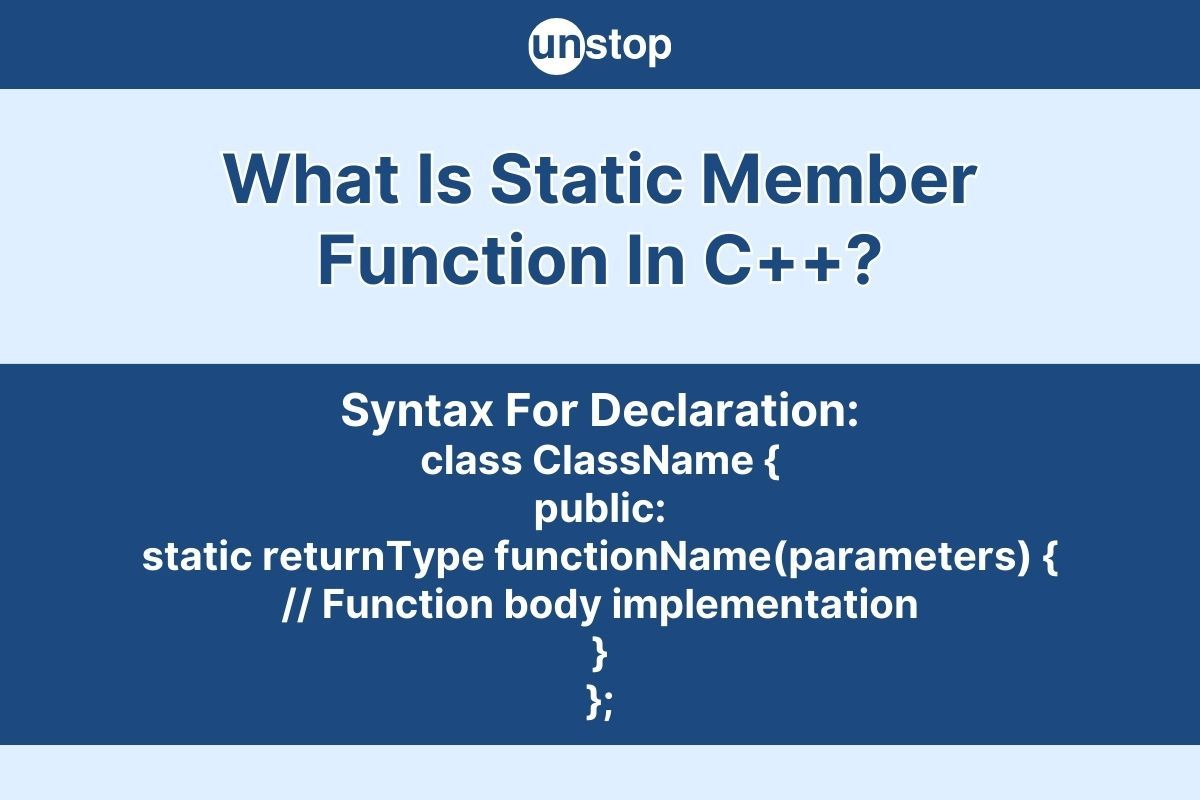
Static member functions in C++ play a crucial role in object-oriented programming, offering a unique dimension to class structures. Unlike regular member functions, static member functions (i.e., static functions inside a class) are associated with the class itself rather than instances of the class. This distinction brings a wealth of benefits and capabilities, making static member functions an essential tool for C++ programmers.
In this article, we will explore the concept of static member functions, their syntax, usage, and the advantages they bring to C++ programming. Whether you're a seasoned C++ developer or just starting your journey, understanding static member functions will open up new possibilities for structuring your code and solving complex problems.
What Are Static Members In C++?
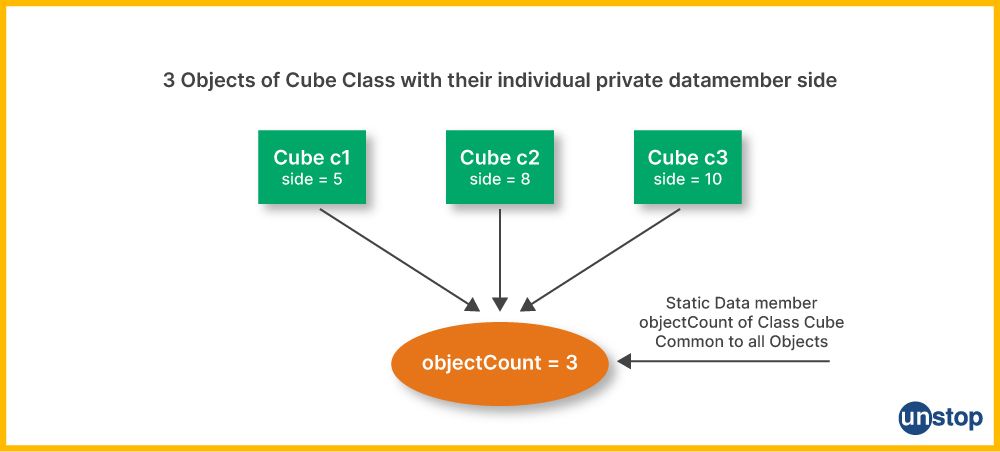
In C++ programming language, static members are class members that belong to the class itself rather than individual instances (objects) of the class. These members are shared among all instances of the class, and they exist independently of any specific object. In other words, static members are associated with the static class as a whole, not with any particular instance of the class.
Static data members (or static variables) are class-level variables that are shared by all instances of the class. They are declared using the static keyword and are typically used to store data that is common to all objects of the class. Static variables/ data members are initialized only once, typically in the class definition, and their values persist across all instances of the class.
Syntax for static member variable:
To declare a static data variable/ member in a C++ class, you use the static keyword before the data member's type and name within the class declaration. The syntax is as follows:
class ClassName {
public:
static dataType staticDataMemberName;
};
Here,
-
The class keyword indicates we are defining a class, which here has been given the name- ClassName.
- Access specifier public indicates that the static member variable contained in it is accessible from outside the class. You can also use private or protected to control access.
- The keyword static indicates that we are defining a static member variable, which here has been named staticDataMemberName.
- The dataType indicates the data type of the static member variable being declared.
Note that here, we have merely declared the static data member. It doesn't allocate memory for the static data member or provide an initial value. It merely tells the compiler that such a member exists within the class. Now, let's take a look at an example showcasing the implementation of the same.
Code :
CODE SNIPPET IS HEREI2luY2x1ZGUgPGlvc3RyZWFtPgoKY2xhc3MgTXlDbGFzcyB7CnB1YmxpYzoKc3RhdGljIGludCBzdGF0aWNEYXRhTWVtYmVyOwp9OwoKLy8gRGVmaW5lIGFuZCBpbml0aWFsaXplIHRoZSBzdGF0aWMgZGF0YSBtZW1iZXIgb3V0c2lkZSB0aGUgY2xhc3MKaW50IE15Q2xhc3M6OnN0YXRpY0RhdGFNZW1iZXIgPSA0MjsKCmludCBtYWluKCkgewovLyBBY2Nlc3MgdGhlIHN0YXRpYyBkYXRhIG1lbWJlciB1c2luZyB0aGUgY2xhc3MgbmFtZQpzdGQ6OmNvdXQgPDwgIlN0YXRpYyBEYXRhIE1lbWJlciBWYWx1ZTogIiA8PCBNeUNsYXNzOjpzdGF0aWNEYXRhTWVtYmVyIDw8IHN0ZDo6ZW5kbDsKCi8vIENyZWF0ZSBpbnN0YW5jZXMgb2YgdGhlIGNsYXNzIChvYmplY3RzKQpNeUNsYXNzIG9iajE7Ck15Q2xhc3Mgb2JqMjsKCi8vIEFjY2VzcyB0aGUgc3RhdGljIGRhdGEgbWVtYmVyIHVzaW5nIGFuIGluc3RhbmNlIChub3QgcmVjb21tZW5kZWQpCnN0ZDo6Y291dCA8PCAiU3RhdGljIERhdGEgTWVtYmVyIFZhbHVlICh2aWEgb2JqMSk6ICIgPDwgb2JqMS5zdGF0aWNEYXRhTWVtYmVyIDw8IHN0ZDo6ZW5kbDsKc3RkOjpjb3V0IDw8ICJTdGF0aWMgRGF0YSBNZW1iZXIgVmFsdWUgKHZpYSBvYmoyKTogIiA8PCBvYmoyLnN0YXRpY0RhdGFNZW1iZXIgPDwgc3RkOjplbmRsOwoKcmV0dXJuIDA7Cn0=
Output:
Static Data Member Value: 42
Static Data Member Value (via obj1): 42
Static Data Member Value (via obj2): 42
Explanation:
-
In this code, we first define a base class called MyClass, within which we declare a static data member named staticDataMember of type int. This data member is declared as public, which means it can be accessed from outside the class.
-
We then define and initialize this data member outside of the class definition. We use the scope resolution and assignment operators to initialize it with the value of 42.
-
In the main() function-
- We access the static data member using the class name along with the scope resolution operator and print its value using the std::cout command. This demonstrates how to access a static data member directly through the class name.
- Next, we create two instances/ objects of class MyClass, called obj1 and obj2.
- We then access the static data member using the class object/ instance and dot operator (i.e., obj1.staticDataMember and obj2.staticDataMember). And we print their value using std::cout.
Important- Note that this is not recommended practice. Static data members are associated with the class itself, not with individual instances. It is typically better to access them through the class name and not the class object.
Static Member Functions in C++
Static member functions in C++ are class-level functions that are associated with the class itself rather than with individual instances (objects) of the class. They are declared using the static keyword, and we can call such a function with a class name without the need to create an object. Static member functions are commonly used for operations that are related to the class as a whole rather than to specific instances.
Syntax:
The syntax for defining a static member function in C++ is as follows:
class ClassName {
public:
static returnType functionName(parameters) {
// Function body implementation
}
};
Here,
- The class keyword is used to define a class with the name ClassName.
- Access specifier public indicates that its contents can be accessed from anywhere in the program. In this sense, the static member function is also a static public member function.
- The static keyword indicates that the function of the name- functionName is static in nature.
- The parameters and returnType refer to the input parameters (if any) taken by the static member function and the data type of its return value, respectively.
- As marked by the code comment, the curly brackets contain the body of the function.
Let's look at an example of a class called MathUtils that contains a static member function for adding two integers. Here, we will define the static member function and then demonstrate how to use it.
Code:
CODE SNIPPET IS HEREI2luY2x1ZGUgPGlvc3RyZWFtPgoKY2xhc3MgTWF0aFV0aWxzIHsKcHVibGljOgpzdGF0aWMgaW50IGFkZChpbnQgYSwgaW50IGIpIHsKcmV0dXJuIGEgKyBiOwp9Cn07CgppbnQgbWFpbigpIHsKLy8gQ2FsbGluZyB0aGUgc3RhdGljIG1lbWJlciBmdW5jdGlvbiB1c2luZyB0aGUgY2xhc3MgbmFtZQppbnQgcmVzdWx0ID0gTWF0aFV0aWxzOjphZGQoNSwgMyk7CnN0ZDo6Y291dCA8PCAiUmVzdWx0OiAiIDw8IHJlc3VsdCA8PCBzdGQ6OmVuZGw7CnJldHVybiAwOwp9
Output:
Result: 8
Explanation:
In the above code,
- We define a class MathUtils with a static member function add() that takes two integer parameters (a and b) and returns their sum.
- In the main() function, we call the static member function add using the class name MathUtils::add. We don't need to create an instance of the MathUtils class to call this function because it's a static member function.
- We pass the integers 5 and 3 as arguments to the add function, and it calculates their sum.
- Finally, we print the result using std::cout.
Ways To Call Static Member Function In C++
In C++, you can call static member functions using the following methods:
-
Using the Scope Resolution Operator (::): This is the most common and recommended way to call static member functions. It provides a clear and unambiguous syntax for accessing static functions associated with a class.
-
Using an Object of the Class: While it's less common and not the recommended practice, you can call a static member function using an object of the class. However, this method can be confusing and is generally discouraged because it can mislead others into thinking that you are calling a non-static member function.
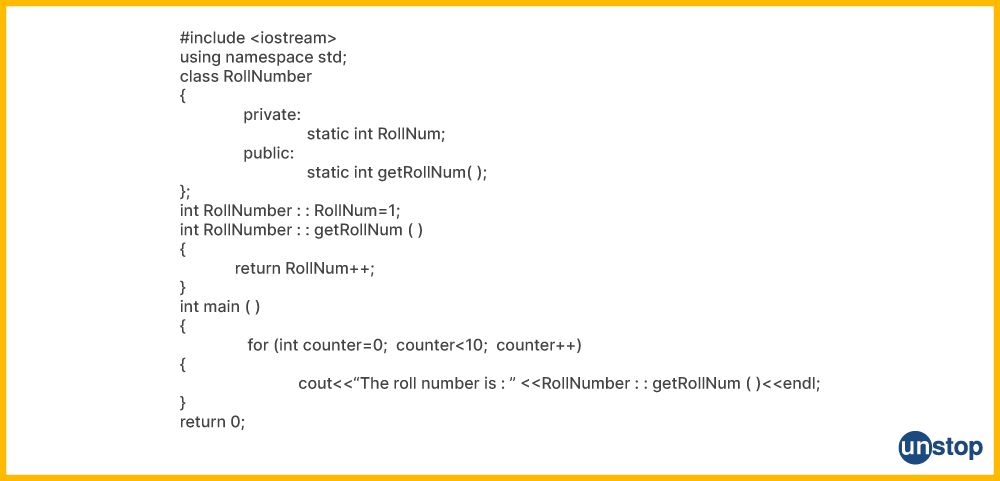
Using The Scope Resolution Operator (::)
The scope resolution operator (::) is the standard and preferred way to call static member functions in C++. It explicitly specifies that you are calling a function associated with the class name itself rather than with a specific instance of the class. Here's an example:
Code:
CODE SNIPPET IS HEREI2luY2x1ZGUgPGlvc3RyZWFtPgojaW5jbHVkZSA8c3RyaW5nPgoKY2xhc3MgUGVyc29uIHsKcHVibGljOgpQZXJzb24oY29uc3Qgc3RkOjpzdHJpbmcmIG5hbWUsIGludCBhZ2UpIDogbmFtZShuYW1lKSwgYWdlKGFnZSkge30KCi8vIFN0YXRpYyBtZW1iZXIgZnVuY3Rpb24gdG8gZ2VuZXJhdGUgYSBwZXJzb24ncyBpbnRyb2R1Y3Rpb24Kc3RhdGljIHN0ZDo6c3RyaW5nIGludHJvZHVjZShjb25zdCBQZXJzb24mIHBlcnNvbikgewpyZXR1cm4gIkhlbGxvLCBJIGFtICIgKyBwZXJzb24ubmFtZSArICIgYW5kIEkgYW0gIiArIHN0ZDo6dG9fc3RyaW5nKHBlcnNvbi5hZ2UpICsgIiB5ZWFycyBvbGQuIjsKfQoKcHJpdmF0ZToKc3RkOjpzdHJpbmcgbmFtZTsKaW50IGFnZTsKfTsKCmludCBtYWluKCkgewovLyBDcmVhdGluZyBhIFBlcnNvbiBvYmplY3QKUGVyc29uIGFsaWNlKCJBbGljZSIsIDMwKTsKCi8vIENhbGxpbmcgdGhlIHN0YXRpYyBtZW1iZXIgZnVuY3Rpb24gdG8gaW50cm9kdWNlIEFsaWNlCnN0ZDo6c3RyaW5nIGludHJvZHVjdGlvbiA9IFBlcnNvbjo6aW50cm9kdWNlKGFsaWNlKTsKCi8vIFByaW50aW5nIHRoZSBpbnRyb2R1Y3Rpb24Kc3RkOjpjb3V0IDw8IGludHJvZHVjdGlvbiA8PCBzdGQ6OmVuZGw7CgpyZXR1cm4gMDsKfQ==
Output:
Hello, I am Alice and I am 30 years old.
Explanation:
-
In the C++ program above, we define a class Person with a constructor that takes a person's name and age as parameters.
-
Additionally, we have a static member function named introduce() that generates an introduction string for a Person object.
-
In the main() function-
-
We create an object of class type Person called alice with attributes- name assigned string 'Alice' and age with value of 30.
-
Next, we call the introduce() static member function, i.e., Person::introduce(alice), to generate an introduction for the alice object. This demonstrates how to use the scope resolution operator to access and call a static member function.
-
The generated introduction is stored in the introduction variable.
-
Finally, we use std::cout to print the introduction to the console.
-
Using An Object Of The Class
While you can technically use the class object to call a static member function, this practice is discouraged because it can be misleading. Static member functions do not operate on object-specific data and should not be called through instances of the class. Here's an example demonstrating this approach:
Code:
CODE SNIPPET IS HEREI2luY2x1ZGUgPGlvc3RyZWFtPgoKY2xhc3MgTXlDbGFzcyB7CnB1YmxpYzoKc3RhdGljIHZvaWQgc3RhdGljRnVuY3Rpb24oKSB7CnN0ZDo6Y291dCA8PCAiU3RhdGljIGZ1bmN0aW9uIGNhbGxlZC4iIDw8IHN0ZDo6ZW5kbDsKfQp9OwoKaW50IG1haW4oKSB7Ck15Q2xhc3Mgb2JqOwpvYmouc3RhdGljRnVuY3Rpb24oKTsgLy8gQ2FsbGluZyB0aGUgc3RhdGljIG1lbWJlciBmdW5jdGlvbiB1c2luZyBhbiBvYmplY3QKCnJldHVybiAwOwp9
Output:
Static function called.
Explanation:
- We define a class MyClass with a static member function staticFunction that simply prints a message to the console using std::cout.
- In the main() function, we create an object of the MyClass class named obj.
- We then call the staticFunction public function using the object obj. This is allowed by the C++ language but is not considered a good practice because it can be misleading.
- The compiler allows it because it's syntactically valid, but it doesn't accurately reflect the intent of calling a static member function in the class body.
Check this out- Boosting Career Opportunities For Engineers Through E-School Competitions
Properties Of Static Member Function In C++
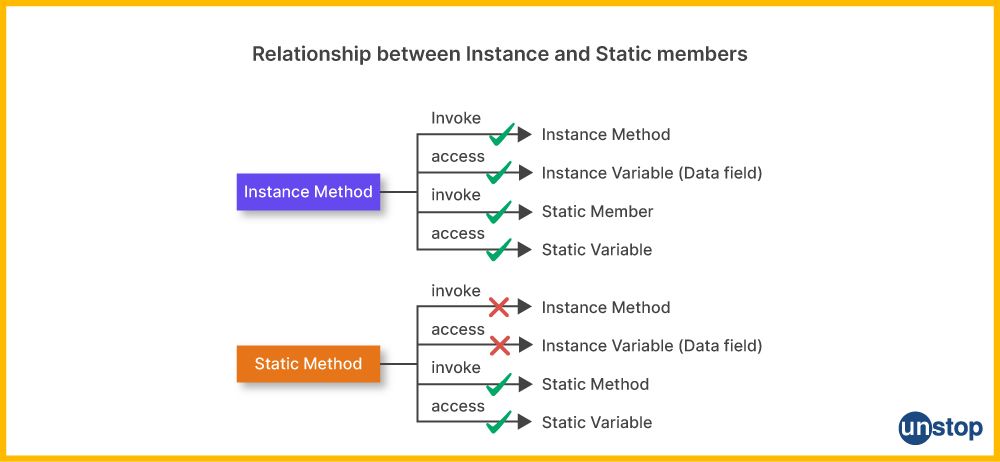
Static member functions in C++ have several distinctive properties that set them apart from regular member functions and make them a valuable tool in object-oriented programming. They are as listed below:
-
Belong to the Class, Not Instances:
- Static member function in C++ is associated with the class itself rather than with instances (objects) of the class.
- They do not depend on the state or data of any specific object. Instead, they operate at the class level.
-
Accessible Without Object Instantiation:
- Static member functions can be called directly on the class without the need to create an instance of the class.
- You do not need to instantiate an object to use a static member function.
-
No 'this' Pointer:
- Since a static member function in C++ is not bound to any object, they do not have access to the implicit 'this' pointer.
- You cannot use 'this' within a static member function because there is no associated instance.
-
Access to Static Members:
- Static member functions in C++ can access other static members of the class, including static data members and other static member functions.
- They can also access global variables and other functions in the same namespace.
-
Cannot Access Non-Static Members Directly:
- Static member functions cannot directly access non-static (instance) members of the class, including non-static data members and non-static member functions.
- If needed, you can pass instances of the class as arguments to a static member function in C++ to access instance-specific data.
-
Use Cases:
- Static member functions are often used for utility functions that perform tasks related to the class as a whole.
- They are suitable for operations that do not rely on the state of individual objects, such as factory methods, mathematical calculations, and singleton pattern implementations.
-
Initialization and Lifetime:
- Static data members within a static member function in C++ are initialized only once when the program starts, typically at the time of their declaration.
- They persist throughout the program's execution and are shared among all instances of the class.
-
Callable Globally:
- A static member function in C++ can be called from any part of the code by specifying the class name followed by the scope resolution operator (::).
-
Polymorphism:
- Static member functions cannot be declared as virtual because they are not associated with instances and do not participate in polymorphic behavior.
-
No Access to 'protected' or 'private' Members:
- Like regular member functions, static member functions have access only to the public members of a class, even if they are declared as friends of the class.
Need Of Static Member Functions In C++
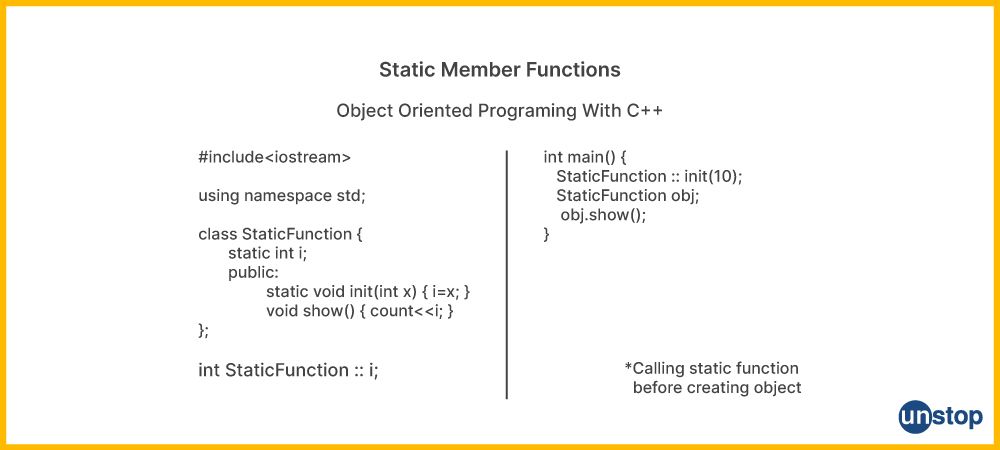
Static member functions in C++ serve several important purposes and offer distinct advantages in various programming scenarios. Here are some key reasons why static member functions are needed and valuable in C++:
-
Class-Level Operations: Static member functions allow you to define operations that are relevant to the class as a whole rather than to individual instances (objects) of the class. This is especially useful when you want to perform actions that do not depend on the specific state or data of objects.
-
No Object Instantiation Means Efficient Code: You can call a static member function in C++ directly on the class without the need to create instances of the class. This means you can use these functions without incurring the overhead of object creation, which can lead to more efficient code execution.
-
Utility Functions: Static member functions are often used to encapsulate utility functions that provide common functionality related to the class. These utility functions can perform tasks such as mathematical calculations, data validation, and formatting, making your code more organized and reusable.
-
Factory Methods: Static member functions in C++ are commonly employed as factory methods that create instances of a class with specific characteristics. Factory methods allow you to control the object creation process and provide a convenient way to initialize objects.
-
Singleton Pattern: Static member functions are crucial for implementing the singleton design pattern, which ensures that only one instance of a class exists throughout the application's lifetime. A static member function in C++ can create and manage a single instance, providing global access to that instance.
-
Global Access: Static member functions can be called from anywhere in your code by specifying the class name followed by the scope resolution operator (::). This makes them accessible globally, allowing you to perform operations that span multiple objects or modules.
-
Code Organization: By grouping related functions within a class and using a static member function in C++, you can improve code organization and maintainability. It becomes clear which functions are associated with a particular class, enhancing the structure of your codebase.
-
Namespace Isolation: Static member functions help isolate functionality within the class's namespace. This can prevent naming conflicts and make it easier to manage complex codebases with multiple classes and libraries.
Regular Member Function Vs. Static Member Function In C++

| Property | Regular Member Function | Static Member Function |
|---|---|---|
| Association | Associated with instances of the class. | Associated with the class itself. |
| Access | Using object instances | Using the class name and scope resolution (::) operator |
| Can access static data members | Yes (via object or class name) | Yes (via class name and scope resolution operator) |
| Can access non-static data members | Yes (via object) | No (unless passed as a parameter) |
| Can access regular member functions | Yes (via object) | No |
| Can access static member functions | Yes (via object or class name) | Yes (via class name and scope resolution operator) |
| Access to 'this' pointer | Yes | No |
| Lifetime | Tied to the object's lifetime. | Tied to the class's lifetime. |
| Initialization | Per instance | Typically, at class declaration |
| Virtual Function | Can be declared virtual | Cannot be declared virtual |
| Polymorphism | Participates in polymorphism | Does not participate in polymorphism |
In summary, regular member functions are associated with instances of a class, can access both static and non-static members, and can be declared virtual to enable polymorphism. In contrast, a static member function in C++ is associated with the class itself, does not have access to non-static members or 'this' pointer, and does not participate in polymorphism.
Also, static member functions are typically used for class-level operations, utility functions, and factory methods, while regular member functions operate on specific instances of the class.
Limitations Of Static Member Functions In C++
Static member functions in C++ offer various advantages, but they also come with certain limitations and constraints that developers should be aware of when using them in their code. Here are the key limitations of using static member functions:
-
Limited Access to Object Data: Static member functions do not have direct access to non-static (instance) data members of a class. They cannot access the state of specific objects because they are not associated with any particular instance. If you need to work with instance-specific data, you must pass instances as arguments to the function static, which can lead to less intuitive code.
-
No 'this' Pointer: Unlike regular member functions, static member functions do not have access to the implicit 'this' pointer because they are not bound to any object instance. Consequently, you cannot use 'this' within a static member function. This limitation can restrict their ability to interact with object-specific data or call non-static member functions.
-
No Polymorphism: Static member functions cannot be declared as virtual functions, which means they do not participate in polymorphism. You cannot override them in derived classes, and they cannot be used in a polymorphic context. This limitation can affect the extensibility and flexibility of your code in some cases.
-
Global Accessibility: While global accessibility can be an advantage, it can also lead to potential misuse if static member functions are called inappropriately or without a proper understanding of their context within the class. This can result in unexpected behavior or unintended side effects.
-
Initialization and Lifetime: Static data members within static member functions are initialized only once when the program starts, typically at the time of their declaration. This may not be suitable for scenarios that require dynamic initialization or cleanup during the program's execution. Static member functions are limited in their ability to manage the lifecycle of resources.
-
Limited Interaction with Non-Static Members: Static member functions are mainly designed for class-level operations and utility functions. They cannot directly access non-static members or modify their values. If you need to perform operations that depend on non-static members, it might be more appropriate to use regular member functions.
-
Not Suitable for Object-Specific Operations: Static member functions are not intended for operations that depend on the state or behavior of specific objects. If you need to perform actions that involve the internal state of instances, regular member functions should be used instead.
-
Less Intuitive Object-Oriented Design: Overuse of static member functions can lead to code that is less object-oriented and more procedural in nature. This can reduce the maintainability and extensibility of your codebase in the long run.
Conclusion
In conclusion, static member functions in C++ represent a powerful and versatile feature that enhances the language's capabilities for object-oriented programming. They enable the encapsulation of class-level functionality, provide a clear organizational structure for utility functions, and allow for the creation of factory methods and singleton patterns. The ability to access them without object instantiation and their global accessibility make them indispensable in various programming scenarios.
However, it's crucial to use a static member function in C++ judiciously, considering the limitations in accessing object-specific data and their exclusion from polymorphism. A balanced approach to code design involves a thoughtful selection of when to employ static member functions and when to rely on regular member functions for object-specific operations. By leveraging the strengths of static member functions while understanding their constraints, C++ programmers can create cleaner, more maintainable, and more efficient codebases. This versatile tool, when applied skillfully, contributes to the robustness and elegance of C++ programs, empowering developers to tackle complex software challenges with confidence.
Also read- 51 C++ Interview Questions For Freshers & Experienced (With Answers)
Frequently Asked Questions
Q. What is a static and non-static member function in C++?
In C++, member functions in a class can be categorized into two main types, i.e., static member functions and non-static (or instance) member functions. These two types of member functions serve different purposes and have distinct characteristics, as mentioned below.
Static Member Function in C++
A static member function is a member function that is associated with the class itself rather than with any specific instance (object) of the class. It is declared using the keyword static in the class definition.
- Static member functions do not have access to non-static (instance) members of the class, including data members and non-static member functions.
- They also do not have access to the implicit 'this' pointer, as they are not bound to any object instance.
- Static member functions can be called using the class name and the scope resolution operator (::), without the need to create an object of the class.
- They are often used for class-level operations, utility functions, factory methods, and singleton pattern implementations.
- Static member functions cannot be declared as virtual, and they do not participate in polymorphism.
The Syntax for Static Member Function In C++:
class MyClass {
public:
static void staticFunction() {
// Implementation of a static member function
}
};
Non-Static (Instance) Member Function
A non-static member function, also known as an instance member function, is associated with specific instances (objects) of the class. It is declared without the keyword static in the class definition.
- Non-static member functions have access to both static and non-static members of the class.
- They can access the implicit 'this' pointer, which points to the specific object they are called on, allowing them to work with object-specific data.
- Non-static member functions are called on objects of the entire class using the object name and the member access operator.
- They can be declared as virtual, allowing for polymorphism and dynamic dispatch in inheritance hierarchies.
The Syntax for Non-Static Member Function in C++
class MyClass {
public:
void nonStaticFunction() {
// Implementation of a nonstatic member function
}
};
Q. Can static functions be virtual in C++?
No, static member functions in C++ cannot be declared as virtual class functions. The concept of virtual functions is associated with polymorphism and dynamic dispatch, which is based on the runtime type of static objects. However, static member functions do not operate on specific object instances and are not bound to any object's state. Therefore, they do not participate in polymorphism, and it's not meaningful to declare them as virtual.
Q. What is the difference between static and constant in C++?
The differences between the static keyword and the const keyword in C++ are given in the table below.
| Aspect | Static | Constant |
|---|---|---|
| Scope | It can be used for variables and functions | Primarily used for variables, parameters, and expressions |
| Variable Lifetime | It can have a lifetime that spans the entire program, even when inside a function. | Lifetime is determined by the block or function where it's defined. |
| Storage Duration | Affects the storage duration, with possible values like static, thread-local, etc. | Does not affect storage duration directly. |
| Value Mutability | Does not inherently imply immutability. | Implies immutability, i.e., the value cannot be changed after initialization. |
| Usage Examples | static int counter = 0; | const double pi = 3.14159; |
| Function Usage | static void func() { /* ... */ } | void process(const int value) { /* ... */ } |
| Member Functions | Static member functions are associated with the class itself, not with instances. | Const member functions promise not to modify the class object's state. |
| Compiler Checks | No compile-time checks for value immutability. | Provides compile-time checks to enforce immutability. |
| Constants | Used for creating static member variables that don't change their value across the program. | Used for creating immutable variables and parameters. |
Q. What is a static free function in C++?
In C++, a static free function is a regular free function (a function that is not a member of any class or namespace) that has the static storage duration specifier. When a free function (a non-member function) is declared as static, it affects the storage duration and linkage of that function. Here's what it means:
-
Storage Duration (Lifetime): When you declare a free function as static, it means that the function's lifetime spans the entire duration of the program. In other words, the function is allocated memory once when the program starts and retains its memory until the program terminates. This is in contrast to nonstatic free functions, which have automatic storage duration and exist only within their respective class scope (e.g., within a specific source file or translation unit).
-
Linkage: When a free function is declared as static, it also affects its linkage. In C++, static linkage implies internal linkage, meaning the function is only visible and accessible within the translation unit (source file) where it is defined. Other translation units cannot access a static free function declared in one translation unit. This provides a form of encapsulation for the function.
Q. What is the example of static members in C++?
Given below is a proper code example of how a static member and a static member function in C++ work, along with the output and explanation of the code.
Code Example:
CODE SNIPPET IS HEREI2luY2x1ZGUgPGlvc3RyZWFtPgoKY2xhc3MgTXlDbGFzcyB7CnB1YmxpYzoKc3RhdGljIGludCBzdGF0aWNEYXRhOyAvLyBEZWNsYXJhdGlvbiBvZiBhIHN0YXRpYyBkYXRhIG1lbWJlcgoKTXlDbGFzcyhpbnQgdmFsdWUpIDogZGF0YSh2YWx1ZSkgewovLyBDb25zdHJ1Y3RvciB0byBpbml0aWFsaXplIHRoZSBpbnN0YW5jZSBkYXRhIG1lbWJlcgp9Cgp2b2lkIGRpc3BsYXlEYXRhKCkgewpzdGQ6OmNvdXQgPDwgIkluc3RhbmNlIGRhdGE6ICIgPDwgZGF0YSA8PCBzdGQ6OmVuZGw7Cn0KCnN0YXRpYyB2b2lkIHN0YXRpY0Z1bmN0aW9uKCkgewpzdGQ6OmNvdXQgPDwgIlN0YXRpYyBkYXRhOiAiIDw8IHN0YXRpY0RhdGEgPDwgc3RkOjplbmRsOwp9Cgpwcml2YXRlOgppbnQgZGF0YTsgLy8gSW5zdGFuY2UgZGF0YSBtZW1iZXIKfTsKCi8vIERlZmluaXRpb24gYW5kIGluaXRpYWxpemF0aW9uIG9mIHRoZSBzdGF0aWMgZGF0YSBtZW1iZXIKaW50IE15Q2xhc3M6OnN0YXRpY0RhdGEgPSAwOwoKaW50IG1haW4oKSB7Ci8vIENyZWF0ZSBpbnN0YW5jZXMgb2YgdGhlIGNsYXNzCk15Q2xhc3Mgb2JqMSg0Mik7Ck15Q2xhc3Mgb2JqMig5OSk7CgovLyBBY2Nlc3MgYW5kIG1vZGlmeSB0aGUgc3RhdGljIGRhdGEgbWVtYmVyCk15Q2xhc3M6OnN0YXRpY0RhdGEgPSAxMjM7CgovLyBDYWxsIGluc3RhbmNlIG1lbWJlciBmdW5jdGlvbiB0byBkaXNwbGF5IGluc3RhbmNlIGRhdGEKb2JqMS5kaXNwbGF5RGF0YSgpOwpvYmoyLmRpc3BsYXlEYXRhKCk7CgovLyBDYWxsIHRoZSBzdGF0aWMgbWVtYmVyIGZ1bmN0aW9uIHRvIGRpc3BsYXkgc3RhdGljIGRhdGEKTXlDbGFzczo6c3RhdGljRnVuY3Rpb24oKTsKCnJldHVybiAwOwp9
Output:
Instance data: 42
Instance data: 99
Static data: 123
Explanation:
In this example-
- We define a class MyClass with two data members, i.e., a static data member staticData and an instance data member data.
- Here, the staticData member is declared as static within the class. It is shared among all instances of the class and is associated with the class itself. We provide a constructor to initialize the instance data member data.
- We also define two member functions in the class. The displayData() member function displays the value of the instance data member using the std::cout command.
- The staticFunction() member function displays the value of the static data member using std::cout.
- In the main() function, we create two instances of MyClass (obj1 and obj2) and initialize them with the values 42 and 99 respectively.
- We then initialize the static data member staticData with the value of 123 using the class name and the scope resolution operator.
- Then, we call the displayData() member function on each instance to display their instance data.
- Next, we call the staticFunction() member function using the class name to display the static data.
This shows how to employ a static data member and a static member function in C++.
Quiz Time!!!
Here are a few other articles to quench your thirst for knowledge:
- References In C++ | Declare, Types, Properties & More (+Examples)
- C++ Templates | Class, Function, & Specialization (With Examples)
- Function Overloading In C++ With Code Examples & Explanation
- C++ Type Conversion & Type Casting Demystified (With Examples)
- Destructor In C++ | Understanding The Key To Cleanups (+ Examples)
An economics graduate with a passion for storytelling, I thrive on crafting content that blends creativity with technical insight. At Unstop, I create in-depth, SEO-driven content that simplifies complex tech topics and covers a wide array of subjects, all designed to inform, engage, and inspire our readers. My goal is to empower others to truly #BeUnstoppable through content that resonates. When I’m not writing, you’ll find me immersed in art, food, or lost in a good book—constantly drawing inspiration from the world around me.
Login to continue reading
And access exclusive content, personalized recommendations, and career-boosting opportunities.
Subscribe
to our newsletter















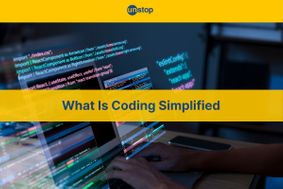
Comments
Add comment